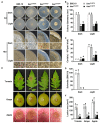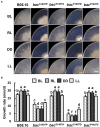Phosphorylation status of a conserved residue in the adenylate cyclase of Botrytis cinerea is involved in regulating photomorphogenesis, circadian rhythm, and pathogenicity
- PMID: 36876105
- PMCID: PMC9975511
- DOI: 10.3389/fmicb.2023.1112584
Phosphorylation status of a conserved residue in the adenylate cyclase of Botrytis cinerea is involved in regulating photomorphogenesis, circadian rhythm, and pathogenicity
Abstract
Adenylate cyclase (AC) regulates growth, reproduction, and pathogenicity in many fungi by synthesizing cyclic adenosine monophosphate (cAMP) and activating downstream protein kinase A (PKA). Botrytis cinerea is a typical necrotrophic plant-pathogenic fungus. It shows a typical photomorphogenic phenotype of conidiation under light and sclerotia formation under dark; both are important reproduction structures for the dispersal and stress resistance of the fungus. The report of B. cinerea adenylate cyclase (BAC) mutation showed it affects the production of conidia and sclerotia. However, the regulatory mechanisms of the cAMP signaling pathways in photomorphogenesis have not been clarified. In this study, the S1407 site was proven to be an important conserved residue in the PP2C domain which poses a remarkable impact on the phosphorylation levels and enzyme activity of the BAC and the overall phosphorylation status of total proteins. The point mutation bacS1407P , complementation bacP1407S , phosphomimetic mutation bacS1407D , and phosphodeficient mutation bacS1407A strains were used for comparison with the light receptor white-collar mutant Δbcwcl1 to elucidate the relationship between the cAMP signaling pathway and the light response. The comparison of photomorphogenesis and pathogenicity phenotype, evaluation of circadian clock components, and expression analysis of light response transcription factor genes Bcltf1, Bcltf2, and Bcltf3 showed that the cAMP signaling pathway could stabilize the circadian rhythm that is associated with pathogenicity, conidiation, and sclerotium production. Collectively, this reveals that the conserved S1407 residue of BAC is a vital phosphorylation site to regulate the cAMP signaling pathway and affects the photomorphogenesis, circadian rhythm, and pathogenicity of B. cinerea.
Keywords: Botrytis cinerea; adenylate cyclase; cAMP; circadian clock; pathogenicity; photomorphogenesis.
Copyright © 2023 Cai, Chen, Li, Ren, Zhang, Wang, Jiang, Zhu, Toyoda and Xu.
Conflict of interest statement
The authors declare that the research was conducted in the absence of any commercial or financial relationships that could be construed as a potential conflict of interest.
Figures











Similar articles
-
A Single Nucleotide Mutation in Adenylate Cyclase Affects Vegetative Growth, Sclerotial Formation and Virulence of Botrytis cinerea.Int J Mol Sci. 2020 Apr 21;21(8):2912. doi: 10.3390/ijms21082912. Int J Mol Sci. 2020. PMID: 32326350 Free PMC article.
-
Regulation of conidiation in Botrytis cinerea involves the light-responsive transcriptional regulators BcLTF3 and BcREG1.Curr Genet. 2017 Oct;63(5):931-949. doi: 10.1007/s00294-017-0692-9. Epub 2017 Apr 5. Curr Genet. 2017. PMID: 28382431
-
The adenylate cyclase (BAC) in Botrytis cinerea is required for full pathogenicity.Mol Plant Pathol. 2002 Nov 1;3(6):439-50. doi: 10.1046/j.1364-3703.2002.00137.x. Mol Plant Pathol. 2002. PMID: 20569351
-
Recent Advances in the Study of the Plant Pathogenic Fungus Botrytis cinerea and its Interaction with the Environment.Curr Protein Pept Sci. 2017;18(10):976-989. doi: 10.2174/1389203717666160809160915. Curr Protein Pept Sci. 2017. PMID: 27526927 Review.
-
Killing softly: a roadmap of Botrytis cinerea pathogenicity.Trends Plant Sci. 2023 Feb;28(2):211-222. doi: 10.1016/j.tplants.2022.08.024. Epub 2022 Sep 30. Trends Plant Sci. 2023. PMID: 36184487 Review.
References
-
- Baek M., Virgilio S., Lamb T. M., Ibarra O., Andrade J. M., Gonçalves R. D., et al. . (2019). Circadian clock regulation of the glycogen synthase (gsn) gene by WCC is critical for rhythmic glycogen metabolism in Neurospora crassa. Proc. Natl. Acad. Sci. U. S. A. 116, 10435–10440. doi: 10.1073/pnas.1815360116, PMID: - DOI - PMC - PubMed
LinkOut - more resources
Full Text Sources

